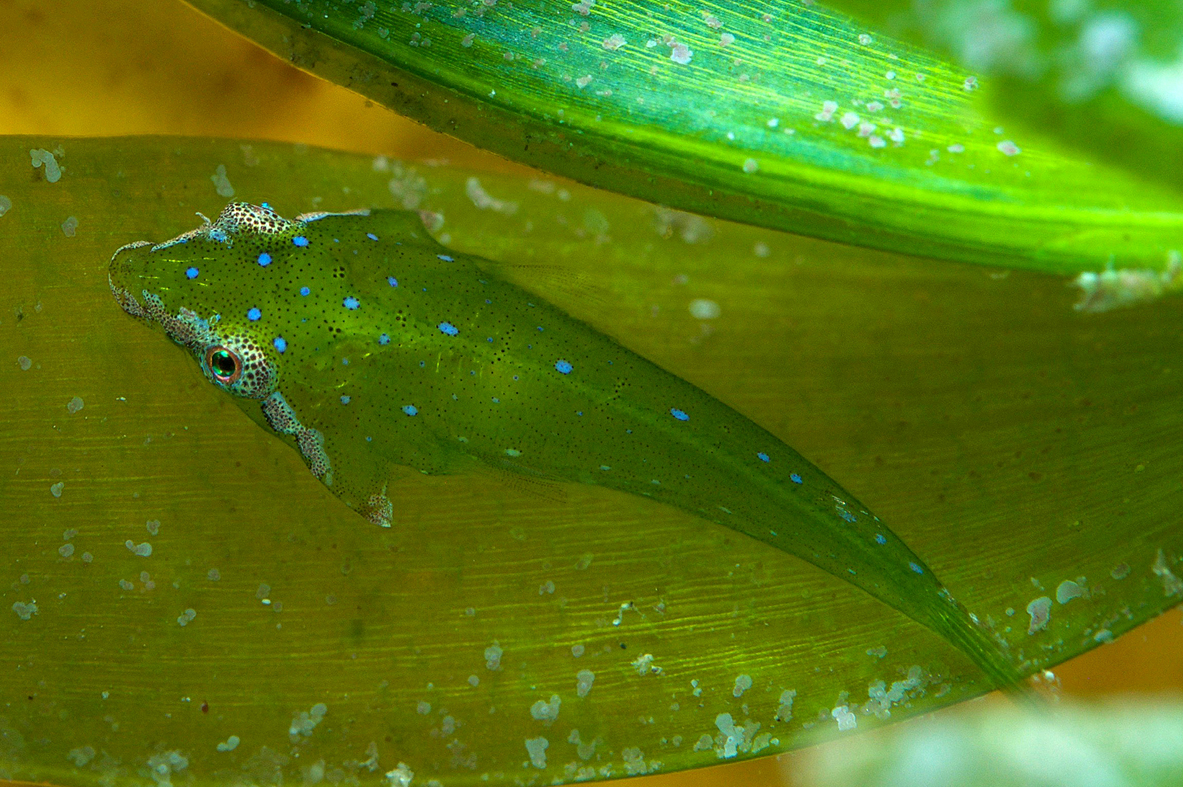Posidonia Clingfish, Posidonichthys hutchinsi Briggs 1993

A female Posidonia Clingfish, Posidonichthys hutchinsi, from Flinders, Western Port, Victoria, March 2016. Source: Kevin Conway / Texas A&M University. License: All rights reserved
A small pale whitish, or greenish to bluish clingfish with fine spots forming dark reticulations on the back and sides, larger blue spots often on the back, and a pinkish to brown stripe from the snout through the eye and across the gill cover. Posidonia Clingfish have a large triangular head with a prominent posteriorly-directed spine on the side of the head near the gill opening.
Posidonia Clingfish, Posidonichthys hutchinsi Briggs 1993
More Info
|
Distribution |
Southern Australia, from Corner Inlet, Victoria, to Port Denison, Western Australia, in depths to 10 m. Inhabits shallow seagrass and macroalgal beds, especially Posidonia australis. |
|
Features |
Dorsal fin 2; Anal fin 2; Pectoral fin 16-18; Caudal fin ~10-12; Pelvic fin I, 4; Vertebrae 32. Body depressed anteriorly, head large, somewhat triangular with a pointed snout when viewed from above; a prominent posteriorly-directed spine on side of head near gill opening - posterior end usually hidden in flesh near gill opening; gill openings not joined across isthmus. Ventral sucking disc obvious. Dorsal and anal fins short, far back on body, not joined to caudal fin. |
|
Colour |
Pale green to pale blue with many minute, close-packed brown spots forming dark reticulations on the back and sides. Back often with larger blue spots. A pale pink to brown line usually on side of snout running through eye to preopercular border. Juveniles are usually translucent with green bars across the back. |
|
Biology |
Gravid females have a conspicuously swollen body. |
|
Etymology |
The species is named in honour of J. Barry Hutchins, Western Australian Museum, for his “excellent work” on Australian clingfishes. |
|
Species Citation |
Posidonichthys hutchinsi Briggs, 1993, Copeia 1993(1): 196, figs 1-2. Type locality: Fiddlers Bay, 16 km south of Tamby Bay, South Australia. |
|
Author |
Bray, D.J. 2022 |
|
Resources |
Posidonia Clingfish, Posidonichthys hutchinsi Briggs 1993
References
Briggs, J.C. 1993. New genus and species of clingfish (Gobiesocidae) from southern Australia. Copeia 1993(1): 196-199 figs 1-2
Conway, K.W., Moore, G.I. & Summers, A.P. 2017. A new genus and species of clingfish (Teleostei: Gobiesocidae) from Western Australia. Copeia 105(1): 128-140 https://doi.org/10.1643/CI-16-560
Hoschke, A., Whisson, G. & Moore, G.I. 2019. Complete list of fishes from Rottnest Island. pp. 150-161 in Whisson, G. & Hoschke, A. (eds) The Rottnest Island fish book. 2nd ed. Perth, Western Australia : Aqua Research and Monitoring Services.
Hutchins, J.B. 2008. Family Gobiesocidae. pp. 722-741 in Gomon. M.F., Bray, D.J. & Kuiter, R.H (eds). Fishes of Australia's Southern Coast. Sydney : Reed New Holland 928 pp.
Whisson, G. & Hoschke, A. 2021. The Perth coast fish book. Perth, Western Australia : Aqua Research and Monitoring Services, 288 pp.












